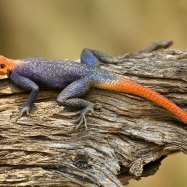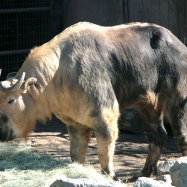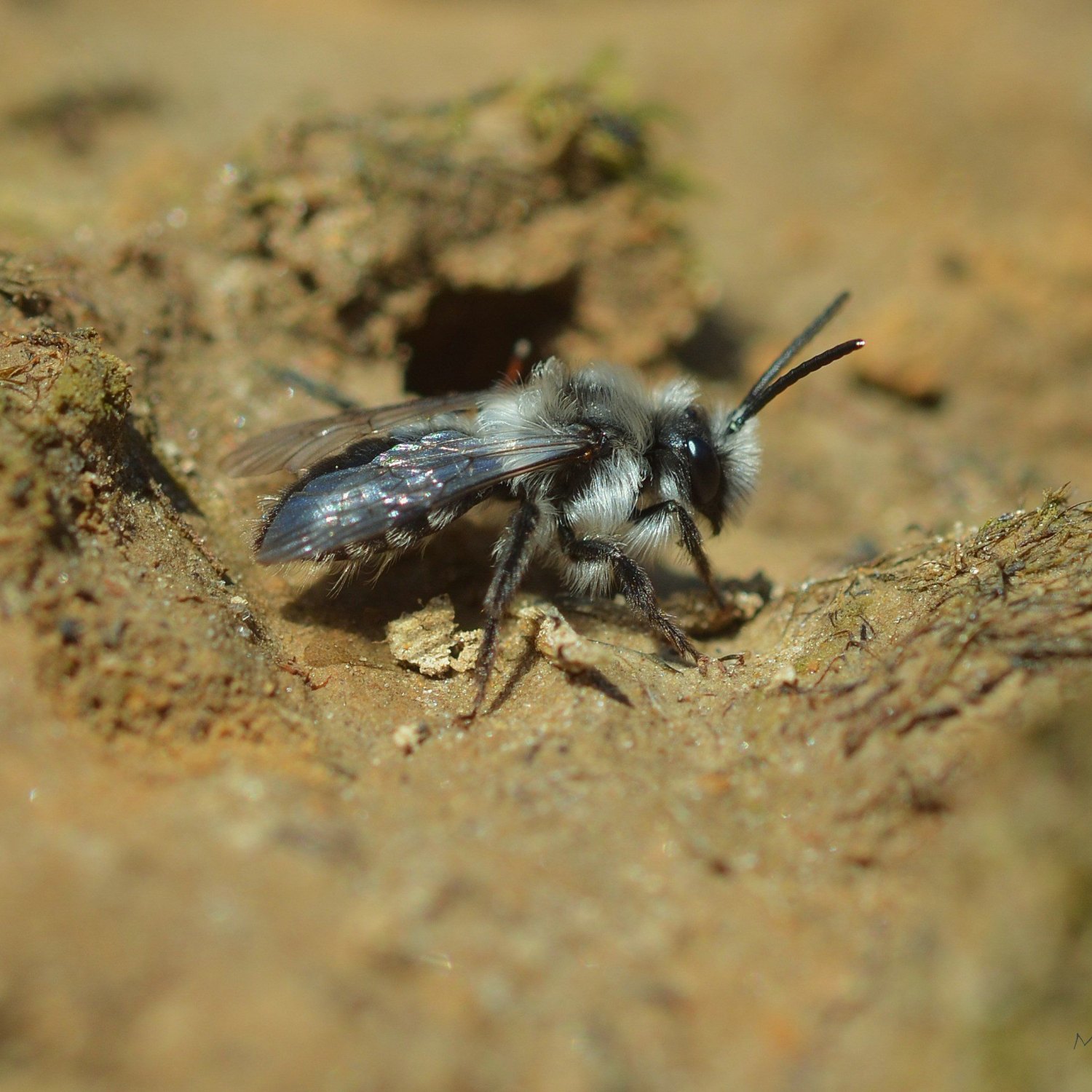
Ashy Mining Bee
8-12 mm
The Ashy Mining Bee is a common sight in grasslands and gardens with its small and slender body measuring 8-12 mm. Belonging to the Andrenidae family, this bee is an important pollinator. Help protect these vital pollinators by avoiding the use of harmful pesticides in your garden. #AshyMiningBee #Pollinators #GardeningTips
Animal Details Summary:
Common Name: Ashy Mining Bee
Kingdom: Animalia
Habitat: Grasslands, meadows, gardens
The Fascinating World of the Ashy Mining Bee
In the world of insects, there is a vast array of unique and fascinating creatures. Some are tiny and barely noticeable, while others are large and intimidating. But no matter their size, each insect has its own story to tell. And in this article, we will explore the incredible life of one particular insect - the Ashy Mining Bee (Andrena cineraria) Ashy Mining Bee.The Ashy Mining Bee, also known as the Common Mining Bee, is a species of solitary bee that can be found in various parts of Europe. Its scientific name, Andrena cineraria, comes from the Greek word "andros" meaning male, and "drepanos" meaning sickle, which is a reference to the shape of the male's antennae. This bee is also commonly referred to as the "Ashy" Mining Bee due to its distinct ashy-grey coloration.
Classification and Habitat
The Ashy Mining Bee belongs to the phylum Arthropoda, which is the largest phylum in the animal kingdom. It is a part of the class Insecta, which includes all insects. This species is classified under the order Hymenoptera, which also includes ants, wasps, and other bees. Within this order, the Ashy Mining Bee falls under the family Andrenidae, also known as the mining bee family.This bee is typically found in grasslands, meadows, and gardens. It is most commonly found in Europe, which is its geographical distribution, while most of its colonies can be found in countries such as the United Kingdom, France, and Germany Angelfish.
Physical Characteristics
The Ashy Mining Bee has a unique appearance that sets it apart from other species. It has a small and slender body, with a length ranging from 8-12mm. The body of this bee is covered in dense, black hairs, giving it a velvety appearance. It also has distinctive ashy-grey bands on its abdomen, hence its name - the Ashy Mining Bee.Unlike other bees, the Ashy Mining Bee lacks the dense hairs on its hind legs, which are usually used for carrying pollen. This is one of the main physical features that differentiate them from other bee species.
Feeding Habits
As adult bees, the Ashy Mining Bee's diet primarily consists of nectar and pollen from flowers. They use their long tongue, called a proboscis, to suck nectar from flowers, and they collect pollen in the hairs on their body while feeding. They play an essential role in pollination, as they travel from flower to flower, transferring pollen and aiding in the fertilization of plants.This species is also very interesting in the way it collects pollen. Unlike other bees that use their hind legs to carry pollen, the Ashy Mining Bee uses its soft, velvety body to collect and transport pollen. This adaptation is believed to be due to their specialized habitat in grasslands, which are often windy, and the excess pollen on their body acts as ballast during flight.
Life Cycle and Behavior
The Ashy Mining Bee is a solitary species, which means that they do not form colonies or live in hives like other bee species. Instead, females will dig tunnels in the ground, often in sand or soil, to lay their eggs. These females are known as mining bees because they excavate underground tunnels to create a suitable environment for their offspring.Once the female has dug her tunnel and lined it with a protective layer, she will collect nectar and pollen to create a food source for her larvae. The female will then lay a single egg on this food source and seal the cell with soil, creating a cozy and safe environment for development.
After a few days, the egg will hatch, and the larva will feed on the stored food. The larvae will go through several developmental stages until it reaches maturity, at which point it will pupate and turn into an adult bee.
The male Ashy Mining Bee is similar to the female in terms of appearance, but they can be easily distinguished by their curved antennae. Once emerging from the pupal stage and developing into an adult, their lifespan is relatively short, lasting only a few weeks. But during that time, they play a vital role in pollination, ensuring the survival and growth of plants in their habitat.
Threats and Conservation
Despite their vital role in pollination, the Ashy Mining Bees, like many other bee species, are facing significant threats. Due to the destruction of their natural habitats, such as grasslands, meadows, and gardens, their population numbers have decreased drastically.Agricultural practices, such as the use of pesticides, also pose a significant threat to these bees, as it affects their food sources and can have harmful effects on their health. In response to these threats, various conservation efforts have been put in place to protect these bees and their habitats. Some organizations have also set up bee-friendly gardens, which provide a safe and suitable environment for them to thrive.
Additionally, as solitary bees, the Ashy Mining Bees are relatively docile and rarely sting humans, making them safe to coexist with in our gardens and outdoor spaces.
Final Thoughts
The Ashy Mining Bee with its unique appearance, behavior, and vital role in pollination, is a fascinating creature that deserves recognition and protection. Its ability to adapt and thrive in various habitats makes it a resilient species, but it is still facing significant threats to its survival.By educating ourselves about these bees and their importance in our ecosystem, and taking steps to create a bee-friendly environment, we can help ensure the continued survival of this remarkable species. So, next time you spot an Ashy Mining Bee in your garden or while exploring nature, take a moment to appreciate its beauty and the important role it plays in our world.

Ashy Mining Bee
Animal Details Ashy Mining Bee - Scientific Name: Andrena cineraria
- Category: Animals A
- Scientific Name: Andrena cineraria
- Common Name: Ashy Mining Bee
- Kingdom: Animalia
- Phylum: Arthropoda
- Class: Insecta
- Order: Hymenoptera
- Family: Andrenidae
- Habitat: Grasslands, meadows, gardens
- Feeding Method: Nectar and pollen
- Geographical Distribution: Europe
- Country of Origin: Most of Europe
- Location: Grasslands and gardens
- Animal Coloration: Black with ashy-grey bands
- Body Shape: Small and slender
- Length: 8-12 mm
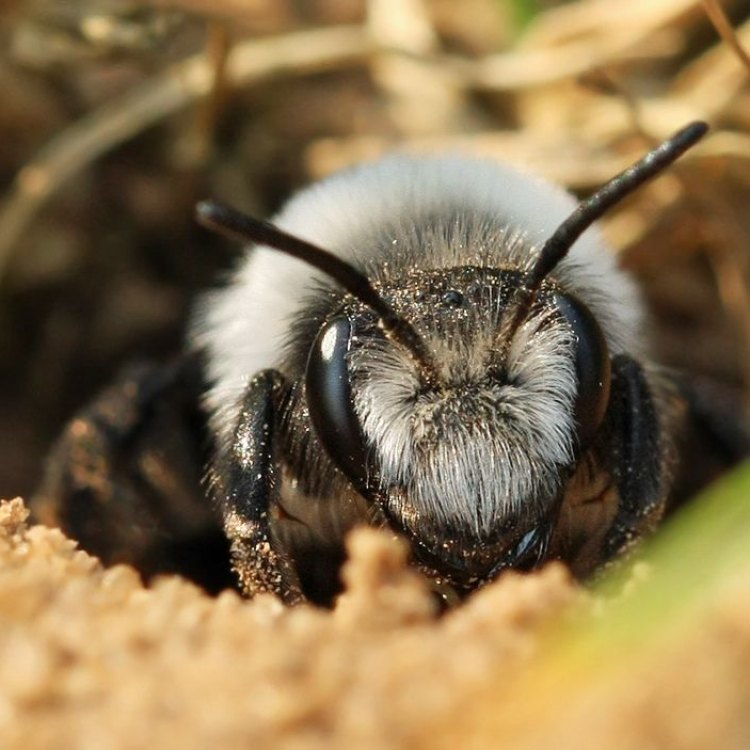
Ashy Mining Bee
- Adult Size: Small
- Average Lifespan: 1 year
- Reproduction: Sexual reproduction
- Reproductive Behavior: Females build underground nests and lay eggs
- Sound or Call: No specific sound or call
- Migration Pattern: Non-migratory
- Social Groups: Solitary
- Behavior: Active during day
- Threats: Habitat loss, pesticide use
- Conservation Status: Not evaluated
- Impact on Ecosystem: Important pollinators
- Human Use: No direct human use
- Distinctive Features: Greyish bands on black body
- Interesting Facts: Male bees emerge earlier than females
- Predator: Birds, spiders
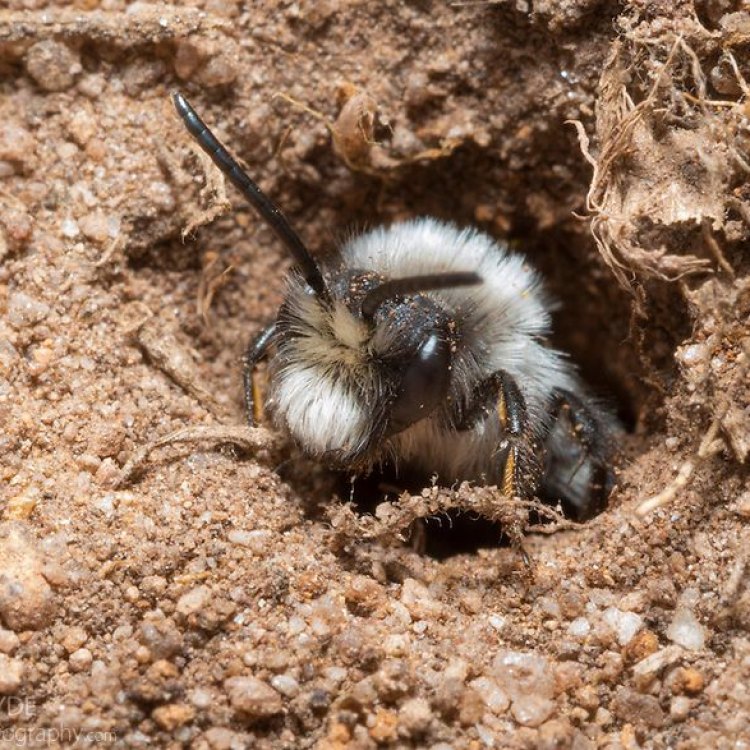
Andrena cineraria
The Fascinating World of the Ashy Mining Bee: A Small but Mighty Pollinator
When we think of bees, we usually imagine a bustling hive with thousands of buzzing workers collecting nectar and pollinating flowers. However, not all bees live in large social colonies. The Ashy Mining Bee (Andrena cineraria) is a prime example of a solitary bee species that plays a crucial role in our ecosystem.With its distinctive greyish bands on a black body, the Ashy Mining Bee may seem like just another ordinary insect PeaceOfAnimals.Com. But don't let its appearance fool you – this small bee is a mighty pollinator with a lifespan of just one year. So, let's delve into the fascinating world of this unsung hero and discover its unique features and behaviors.
Size and Lifespan
The Ashy Mining Bee is classified as a small bee species, measuring only around 8-10 millimeters in length. Compared to other bee species, it may seem tiny, but don't underestimate its abilities. Despite its small size, this bee has a remarkable lifespan of one year. This may not seem like much, but for a solitary bee, it's quite impressive.
Reproduction and Behavior
Like most bee species, the Ashy Mining Bees reproduce through sexual reproduction. However, their mating behavior is quite different from other bees. During the spring season, the male bees emerge from their underground nests earlier than the females American Pygmy Goat. They patiently wait for the females to emerge and then engage in a courtship dance to attract a mate.
Nest Building and Egg-Laying
The female Ashy Mining Bee may be small, but she is a hardworking and resourceful builder. After mating, she sets out to find a suitable nesting site in the ground. She digs a narrow tunnel, creating several chambers along the way. These chambers play a crucial role in the bee's survival – they serve as storage for food and shelters for the developing bees.
Once the nesting site is complete, the female starts to collect pollen and nectar from nearby flowers. She stores this food in the first chamber and then lays her eggs nearby. Once the egg hatches, the larva feeds on the stored food until it reaches adulthood. The adult bee emerges in the spring of the following year, continuing the cycle of life.
Sounds and Calls
Although the Ashy Mining Bees do not have a specific sound or call, they play an essential role in the background noise of our ecosystem. Like other bee species, they buzz as they fly from one flower to another, pollinating plants and creating a symphony of sound in nature.
Social Groups and Behavior
Unlike the traditional image of bees living in large colonies, the Ashy Mining Bees are solitary creatures. They do not live in hives or have a queen bee to rule over them. Instead, each female builds her own nest and raises her offspring independently.
During the day, these bees are highly active, pollinating plants and collecting food for their offspring. They have a close relationship with certain plant species, and their pollination activities contribute significantly to the survival of these plants.
Migratory Patterns
The Ashy Mining Bees are non-migratory creatures, meaning they do not travel long distances to find food or seek shelter. They prefer to stay close to their nesting sites, which they work hard to build and maintain.
Threats and Conservation Status
Unfortunately, like many other bee species, the Ashy Mining Bee is facing habitat loss due to human activities. As urbanization and agriculture continue to expand, the bee's natural habitats, such as meadows and grasslands, are being destroyed, leaving them with limited food sources.
Additionally, the use of pesticides in farms and gardens also poses a significant threat to this bee species. Pesticides can be fatal to bees, and even low doses can affect their behavior and reproduction.
Unfortunately, due to limited research, the Ashy Mining Bee has not yet been evaluated for its conservation status. However, it is essential to raise awareness about their importance in our ecosystem and take measures to protect their habitats.
Impact on Ecosystem
Bees, including the Ashy Mining Bees, play a crucial role in maintaining the balance of our ecosystem. As pollinators, they distribute pollen between plants, enabling them to reproduce and produce fruits and seeds. This process is essential for the survival of many plant species, making bees an integral part of our food chain.
Human Use
Unlike other bee species, the Ashy Mining Bee does not have any direct human use. They do not produce honey or wax, and they are not used in agriculture for pollination purposes. However, as important pollinators, they indirectly contribute to the production of crops and the maintenance of biodiversity.
Distinctive Features
The Ashy Mining Bee has several unique features that make it stand out from other bee species. Their black bodies with greyish bands give them a distinct appearance. This coloration serves as a form of camouflage, making it challenging to spot them in their natural habitat.
Interesting Facts
- As mentioned earlier, male Ashy Mining Bees emerge earlier than females. This is a unique behavior among bees and has earned them the nickname "parsley bees" because they emerge around the same time as parsley and chives.
- The Ashy Mining Bees are excellent navigators. They use visual cues to locate their nests, using landmarks like trees, buildings, and even individual flowers to guide them.
- These bees are active during the day, following a diurnal rhythm. They rest at night, tucked safely into their underground nests.
Predators
Like most insect species, the Ashy Mining Bee has its fair share of predators. They face threats from predators such as birds, spiders, and other insect-eating animals. Being small in size, they are vulnerable to attacks and must constantly be on the lookout for potential threats.
However, these bees have evolved to adapt to the dangers around them. Their coloration helps them blend in with their surroundings, making it difficult for predators to spot them. Additionally, their underground nests provide them with shelter and protection from predators.
The Importance of Conservation
As we now know, the Ashy Mining Bee plays a vital role in our ecosystem as a pollinator. Without them, many plant species would not be able to reproduce, significantly impacting our food chain and biodiversity.
It is crucial to take steps to conserve the habitats of these bees and reduce the use of harmful pesticides in our environment. Simple actions like planting native flowers and creating bee-friendly habitats in our gardens can go a long way in protecting this species.
In conclusion, the Ashy Mining Bee may be small, but its impact on our ecosystem is significant. As we continue to learn about the hidden world of these solitary creatures, it is crucial to appreciate their importance and take measures to protect them. Let us all play a role in preserving these unsung heroes of the bee world and ensure their survival for generations to come.
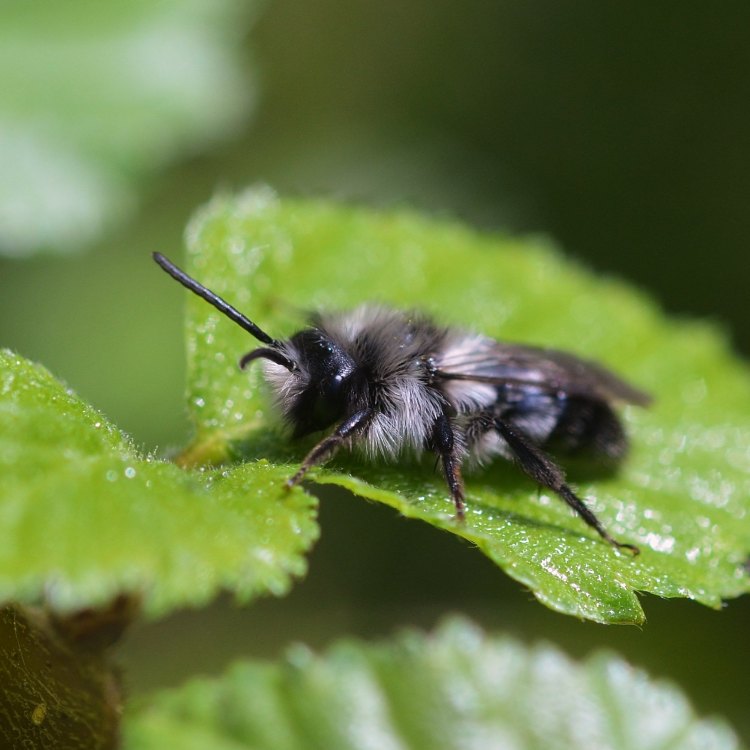
The Fascinating World of the Ashy Mining Bee
Disclaimer: The content provided is for informational purposes only. We cannot guarantee the accuracy of the information on this page 100%. All information provided here may change without prior notice.

